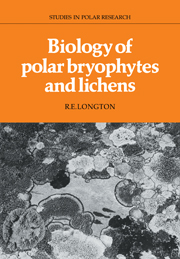Book contents
- Frontmatter
- Contents
- Preface
- 1 The polar regions
- 2 The cryptogamic vegetation
- 3 Pattern, process and environment
- 4 Radiation and microclimate
- 5 Physiological processes and response to stress
- 6 Vegetative growth
- 7 Cryptogams in polar ecosystems
- 8 Reproductive biology and evolution
- References
- Index of generic and specific names
- Subject index
7 - Cryptogams in polar ecosystems
Published online by Cambridge University Press: 24 April 2010
- Frontmatter
- Contents
- Preface
- 1 The polar regions
- 2 The cryptogamic vegetation
- 3 Pattern, process and environment
- 4 Radiation and microclimate
- 5 Physiological processes and response to stress
- 6 Vegetative growth
- 7 Cryptogams in polar ecosystems
- 8 Reproductive biology and evolution
- References
- Index of generic and specific names
- Subject index
Summary
Energy flow
Production and phytomass
Definition and estimation Bryophytes and lichens are major elements in the tundra communities described in Chapter 2 in terms of cover and also energy flow, mineral nutrient cycling and other dynamic aspects of polar ecosystems. The part played by bryophytes has been briefly reviewed (Longton, 1984). Here we shall explore the role of both groups in greater detail, beginning with the contribution of cryptogams to production and phytomass.
Phytomass is the amount of plant material present, and thus potentially available to consumers and decomposers. Vascular plant phytomass comprises above- and below-ground components, the latter including living and dead, and the former green, other living, standing dead and litter. Only photosynthetic (green) and non-photosynthetic components can realistically be distinguished in many cryptogams because of difficulties in determining how far living tissue extends into the colonies (Chapter 6), and most published estimates of living phytomass probably represent the green component. Mosses and lichens decompose from the base with little surface litter deposition. Phytomass varies seasonally, particularly in flowering plants; the value recorded near the end of the growing season is that most commonly reported.
Above-ground phytomass is determined by harvesting and dry-weighing plants from sample plots of known area, those for cryptogams normally comprising cores through colonies of one or an assemblage of species. The results are extrapolated to phytomass per unit area assuming continuous cover, and this value multiplied by percentage cover indicates phytomass of the species concerned in the community. Below-ground phytomass is assessed from cores through the phanerogamic rooting zone.
- Type
- Chapter
- Information
- Biology of Polar Bryophytes and Lichens , pp. 253 - 309Publisher: Cambridge University PressPrint publication year: 1988
- 1
- Cited by



